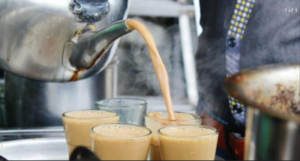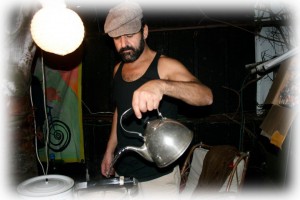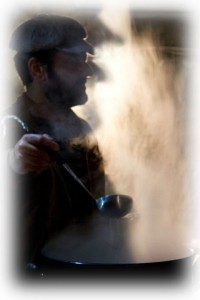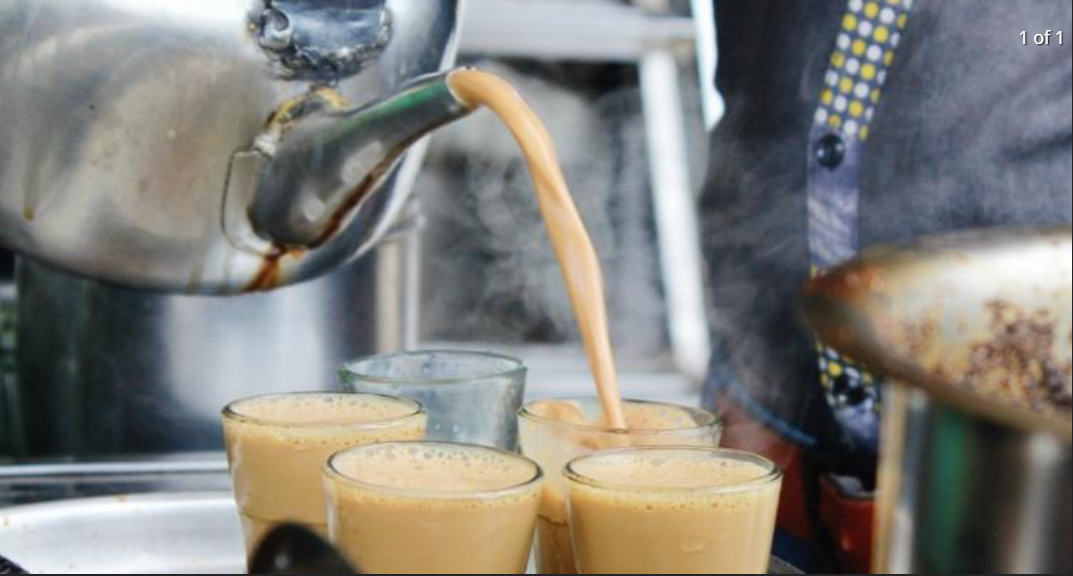Hello good people,
I was asked so I wrote down the secrets of the vegan Milk chai that I was blessed to prepare and serve for 15 years all over the world.
The times I served chai, dozens of people approached me and asked for the recipe, and of course I handed over the ingredients of the chai and also some tip, but I never had the opportunity to fully convey the spirit behind the preparation and serving of the chai.
The first thing to keep in mind when making chai is that chai is a sacred medicine drink that gives people a gift for body, mind and soul.
Once you understand this from the inside, it will be much easier to follow the basic rules in preparing the chai and how it is served. After years of watching people drinking chai in one place, I was finally able to understand that it dissolves people’s heart barriers and then it’s easier for them to get closer to each other. Literally.
Chai is much more than a hot drink.
Already before drinking the chai there are the smells, the heat of the pot, the steam, the look in the eyes when serving and the gratitude of the recipients (even if it is without words).
During the explanation of how the chai is made, I will give the energetic and spiritual angle of the matter, because they always go together, the practical side and the spiritual side.
Of course, you can make chai technically, maybe like you make a cup of tea at home, but anyone who has tasted the right magic in it will certainly want to taste the magic again and not settle for delicious chai, but will ask for at least an amazing chai !!
The recipe refers to vegan chai with almond or soy milk (almonds are recommended), but the chai can also be made with cow’s milk.
For those who are used to cow’s milk, strongly recommend trying to prepare at least once with organic almond milk and only then decide on the next time.
Something amazing that happens in the preparation of chai according to this recipe, that on the basis of almonds it comes out tastier than cow’s milk, just like that. And yet I respect those who want to make the original Indian chai based on cow’s milk.
A few words about the energy of the chai
As you will see in the recipe below, there is no type of tea in the ingredients and no caffeine or theine.
The recipe is structured in such a way that it assembles the chai in a balanced energetic way, which restores balance to the body and creates a feeling of relaxation, yet high energy and alertness.
Unlike coffee, there is no energetic jump after drinking and then Energy drop, but a feeling of something good that has entered the body and you want it to stay there.
Temperature
It is important to serve the chai boiling, but ask the people to wait at least 2 minutes before the first sip. One of the reasons is that the real taste is revealed when it starts to cool down and not when it boils, and the second reason has to do with the physical and energetic effect of the chai on the body.
Cups
There is only one answer to the question of which cup is best to serve chai: glass cup!
Not in cardboard, not in plastic, and heaven forbid not in styrofoam.
The glass cup retains the delicate taste of the chai and provides a homely feeling, which is a very important part of the chai interesting. If you are reading these lines with the intention of chai for large events that do not permit the use of glass, then go for cardboard cups (or natural materials such as processed corn leaves, etc.) as the next option. I will never recommend you go for the plastic or styrofoam option, it’s just not a way to serve chai and the ingredients the cup is made of will transfer toxins into the chai.
I’ve seen places that served chai in stainless steel cups, which keeps the chai taste good and is also clean, and if you have the budget for that, then it’s a good option as well. (less good than glass) Note that stainless steel cups transfer heat, so there is a chance of burning, so certainly don’t serve people chai in a boiling stainless steel cup.
Cookware and equipment
- Gas hob – with a good fire regulation so a small flame is possiable if desired.
- A large pot – (depending on the amount of people) is made of stainless steel, aluminum or cast iron, with
 iron being the preferred material
iron being the preferred material- Large lid for pot – (after cooking the lid will be very hot. You can tie a piece of cloth to the handle)
- Pouring ladle – can be a soup ladle with a pouring socket, or a stainless steel cup attached to a rod/stick
- Cutting board – to cut the ginger and spices
- A crater and a large leaf – to crush the spices (just some of them. You can get along great with a cutting board and a knife)
- Cuttering kitchen knife
- Water tank – for filling the pot
- Glass cup – for tasting the chai
- Serving counter – made of material that can be washed with water
~ The quantities are adapted to a huge pot of 30-40 liters, which is suitable for a large amount of people at events or festivals. It is possible to calculate more or less the quantities and adjust them to a home cooking pot, which will usually contain about 5-7 liters~.
Groceries
- Whole cinnamon sticks – 10 sticks of 10 cm
- Whole cloves – a handful, half a cup
- Whole cardamom – whole glass
- Fresh ginger – great root
- Whole nutmeg – 10 medium nuts
- Whole anise flowers – 5 units
- Vitriz almond/soy milk – 5 liters
- Light brown sugar (of cherry bud works well) – 1.5 kilos
- Whole black pepper – 5 grains
- Salt – 1.5 teaspoons
Important Chai tips
Space and cleanliness – first we will create a clean and energetic space, we will clear the waste, we will wash the pot well and the mixing and serving utensils, and we will make sure that we have good water for making the chai.

Remember that the quality of the water is very important for the taste and success of the chai, I have already seen cases where a huge pot of chai was poured into the ground that tasted repulsive, just because the water was poor. The most delicious is to make chai from spring water of reverse osmosis. (special filter system). you can also have mineral water if you have a budget, and in any case taste the water before pouring it into a pot. Perhaps then you will find that it was a wise act to do. If you are using tap water then it is recommended to fill the pot with water and leave it in the open air for an hour, so that the chlorine evaporates.
As for the space
In which the chai is cooked, let there be a positive space in which you, as the chai maker, feel free and good. For example, cooking chai while on the phone with a bank manager who wants to cancel your credit limit is a really bad idea.
The rule – what you give is what you ge -t works great when it comes to making chai.
During the entire serving time keep the counter clean, be tight to a wet cloth and clean all places where chai is spilled.
Hygiene
When people come to buy chai it can be for two main reasons: the delightful smell or they saw someone drinking chai and it cost them a craving.
Then they get to the chai area and the first thing they usually see is the chai presenter. I guess they will want to see a neat and clean person, who smells good. With your permission, I spare us from writing/reading about embarrassing situations of lack of hygiene. Please wash your hands many times during preparation and serving, whenever there is a small doubt, wash your hands with soap. If a vessel fell on the floor, wash properly, etc.
Amounts
I tried to write an estimate of the quantities I usually put in the pot (I have never measured or weighed quantities), but please people, do not count the cardamom grains you put in the pot, but feel how right it is to put. The quantities refer to a large pot for the amount of about 100 cups (about 30-40 liters), which is the pot in which I usually make chai at festivals or events. If you want smaller quantities then change the quantities accordingly.
Usually
People need precise measurements to make something they have never prepared, and it’s okay the first few times to measure in cups and spoons, just know that the quantities can never be accurate in every chai preparation, also because in every spice store they will be of a different intensity, the amount of sugar changes the taste of spices, the long cooking time strengthens some spices and weakens others, Thus, the quality of the water and energy of the chai maker will have the greatest impact on the taste of the chai.
Sometimes you put the spices and after cooking for fifteen minutes you realize that you have to add a certain spice, it’s a matter of taste and feeling, and the rest will come with the experience.
How sweet?
Regarding the recommended amount of sugar, this recipe was written to make sweet chai. Those who avoid sugar or like little sugar can change the amount of sugar or avoid adding it. You can also put dates in chai to sweeten it, but this will change its delicate texture.
Personally, I don’t have much experience in making sugar-free chai, so you’ll have to find out for yourself the amount of spices and the desired sugar-free cooking time. Keep in mind that sugar brings out a stronger flavor from certain spices and weakens the taste of other spices, so research and try.
In any case
please do not put artificial sweeteners in chai, partly because it will have an aftertaste, partly because of the tremendous damage they do to the body and soul, and also because I have never tried it and it may have a negative effect on the body. I always use light brown sugar – from sugar cane. It is really not recommended to use dark brown sugar with molasses, because it will color your chachi in dark brown and take over all the flavor of the spices. It doesn’t turn out tasty, you can save a painful experience.
Harmony in Making Chai
As you see in the explanations, making chai is one unit, one whole action. Just like the human body, if we remove an organ from it, it will no longer be the same body.
Preparation
First we will fill half of the pot with water and put on a large flame so that they will warm up. It is not recommended to boil water in an electric kettle, but let the natural heat process of the fire do its thing. Fire is part of it.
At the same time we will crush nutmeg, cardamom grains, break the cinnamon sticks into pieces of about 5 cm, and cut thin strips of the fresh ginger.
During the crushing and cutting of chai spices
Do not mix them, but rather, that each spice will be in its own saucer. This is because, once the spices touch each other, they change their flavor and lose their special hue, and with such spices it is impossible to make a delicious chai. Let them meet each other in the pot.
Start cooking the Chai
We put the spices in a saucepan one by one. First enters the cinnamon, followed by the ginger, cloves, nutmeg, cardamom. Bring the saucepan to a boil and another ten minute cooking over medium heat. It is important that the water is bubbling to remove the flavor from the spices.
The next step is the introduction of black pepper and anise, both of which are considered delicacies of flavor, one spicy and the other sweet. Another ten minute cooking.
At this point, the kitchen is already filled with the smell of spices and the heart begins to melt. (I wrote this step of about 20 minutes, but if you are not in a hurry give it more too)
Now it’s the almond/soy milk stage (yes yes I remember that there is also salt and sugar.. patience).
It’s time to lower the flame…. And add the almond milk at an even rate so that no lumps form. Simply pour the entire amount of almond milk into a saucepan.
Wait a bit.
Now we already have beige white chai in the pot, and it’s time to increase the fire and bring it to a boil with the milk.
And here there is an important point.
After the first boil, lower the heat and immediately add the sugar so that it consolidates the chi and prevents the milk from crystallizing.
At this point we leave the chai for cooking over low heat and it is already possible to add the pinch of salt and stir.
During cooking
We mix the chai with the large soup ladle, but the mixing is in a different way than you know. We simply pour chai into the pot again and again, from a height of about 20 cm, thus ventilating the delicious chai and adding a fragrant aroma to it.
At this point, you have to be with the chai completely. Don’t talk to your aunt on the phone and don’t mess with Facebook. Just be with the chai and bring an intention of medicine and love. Put there whatever prayer you want to be a blessing when people drink the magic drink you made.
After 15 minutes of further cooking The chai is ready to drink
But keep in mind that the more it cooks, the tastier it will be.
There were times when I cooked chai for two days and it tasted like heaven.
If you do chai at an event
And the pot reaches a quarter of the amount, then do not let it run out to the end, but – add boiling water (never cold water), spices and milk and continue cooking before serving.
You’ll see that it works like a charm. More and more wonder drink comes from the pot.
The amount of spices to be added is about half the amount, because the spices at the bottom of the pot will continue to give a strong flavor and aroma. If these are fresh spices, you will be surprised by the amount of flavor they can give more and more.
Long cooking of chai
During the cooking of the chai (which can be many hours or even days) keep the lid closed, but not fully closed so that the chai does not overflow.
So that the chai stays clean and doesn’t get dust and other flying things into it, and especially if we’re talking over the chai pot (you should find out on the Internet how much saliva is ejected from the mouth during speech) then we certainly want the pot to be covered.
Covering the pot will also prevent the water from evaporating quickly.
In any case
once an hour you should taste the chai to check that it has not become too concentrated or sweet, and if so then add boiling water, and sometimes a little more milk. .
Delicious
The question arises, is the chai master allowed to taste directly from the pot? From the ladle?
The answer I give is no! Not at all!
In order to respect all the people who will drink from this chai, it must be kept sterile and clean throughout, so that it is not an issue to taste the chai directly from the ladle, even if it seems idle to you in the sixties, there is an energetic matter here, and many of the people who will see you taste the ladle and put it back in the pot, will just disgust and will not want to drink (I am among them).
Please respect the chai all the way.
The right way to taste The Chai
pour with the ladle half a glass (glass) of chai and wait for it to cool a little before tasting. If you taste too fast, you won’t know what the chai actually tastes like or its true sweetness (heat changes your sense of taste to sweetness) and you might add unnecessary ingredients to get it out of balance. Remember that people usually drink the chai after a few minutes and this is how you should taste it.
Pouring and serving
After the chai man/woman decided that the taste of the chai is palatable and respectable to serve, it’s time to share it with people.
A few things about pouring
- Do not pour over the open pot, always pour out of the pot. I’ve had many cases where the glass has cracked and fallen out of my hand, or it’s just slipped for one reason or another, and we don’t want the pieces of glass to be in the pot. Beyond the fact that during pouring, chai drips from the glass, which is not always clean in its outer parts. Respect and cleanliness we have already said.
- At the moment of pouring you should be quiet, just do not talk. Even if it’s hard for some people, it’s just a few seconds of kindness. Meditation.. A small prayer. Just enjoy the pouring and let the person watching enjoy it as well.
You will find that the moment of pouring is a kind of small ritual of a moment, which brings a deep smile to the faces of those who receive the chai. - When pouring the chai, the cup should be held with two fingers at the top of it, on the upper level where the chai will not reach, because once the chai level reaches where the fingers are it will become hot. Really hot. After a few such times there will be a burn. So let’s keep the chai presenter safe and sound.
- After pouring, there is one important safety rule that I would like to remember: place the glass on the counter and not hand it over directly to the person.
One can talk a lot about this moment of passing the chai to a person, especially if he is a child, and tell you about embarrassing and other dangerous cases that happened while passing the boiling chai over the counter.
In principle, it is much easier for a person to collect a cup from a counter than to take it from another person’s hand, this way he will also have the opportunity to touch the glass and estimate its temperature before picking it up. - If you have filled the cup a little too much, Do Dot Pour Back Into The Pot.
Even if there is a good reason whatever, do not pour back into the pot! Beyond the health issue it should be remembered that the chai pot is a one-way emanation of energy, and once this emanation is charged with the right energy, it will give and give as much as you ask. Like a spring that emanates only from it outwards, so is the chai pot, a spring that gives itself to the world.The one time I did not follow this rule, I passed a boiling glass to a kind girl who shone with happiness at that moment. On the very same occasion, new glass cup of bad quality were bought (which I did not know before) and there was an incident in which she held the glass, when it split in half and fell out of her hand. Luckily nothing happened to anyone.
On the same subject
Do not pour boiling chai into a wet or cold glass. If you don’t have enough time to wait for the cups to dry, then put them on the lid of the pot to keep them warm, or heat water in another pot and place the glasses in it (don’t boil, about 60 degrees) and then pull out the glasses and pour chai in them. In this way there will be no extreme temperature change and the glasses will remain intact. (especially in winter when the air is cold)
And in conclusion
Give from the heart and be kind to people will be the perfect spiritual practice that will leave everyone with a taste of more
Thank you for reading this far
Ilan Aviv
Plesae Comment here
I will Answers every inquiry



Leave A Comment